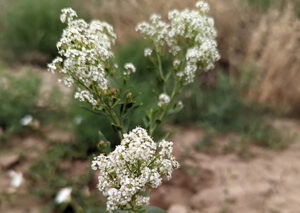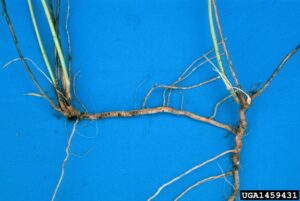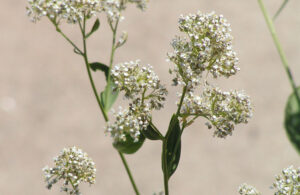Perennial Pepperweed
Lepidium latifolium
Perennial pepperweed is a member of the mustard family (Brassicaceae). Populations form dense monocultures that are easily spread by root fragments and seed. This plant can establish in a wide range of environments to including flood plains, pastures, roadsides, and residential sites.
Plants grow up to 6 feet tall. Leaves are bright to gray-green with toothed to entireedges and have a prominent white mid-vein. Basal leaves are larger than upper leaves.
Multiple stems grow from the crown. Older stems are woody and can persist, forming a thicket that inhibits other plants from growing.
It has small white flowers that form in dense clusters near the end of the branches. Two seeds form in rounded, flattened and slightly hairy reddish-brown fruits.
Perennial pepperweed probably entered the US prior to 1940 in a shipment of beet seed (Beta vulgaris) from Europe.
It prefers to grow in moist areas but can adapt where conditions are drier. Perennial pepperweed is saline tolerant. It is also a salt pump, that is the rhizomes absorb salt from the soil, accumulate it into its leaves, and upon senescence its salty leaves fall tothe soil. Salinity does not appear to affect seed germination. This plant is known to thrive where Salt cedar (Tamarisk spp) populations exist.
Herbicide treatment is best at the early bud stage or in the fall. Removal or cultivation is not very effective in large established sites because the root system extends deeply in the soil and fragments will give rise to new plants.
Resources
UC IPM How to Manage Pests http://ipm.ucanr.edu/PMG/PESTNOTES/pn74121.html
USDA Field Guide for Managing Perennial Pepperweed in the Southwest https://www.fs.usda.gov/Internet/FSE_DOCUMENTS/fseprd563037.pdf
Photos
Roots: Steve Dewey, bugwood.org
Flower Alicia Doran and Ethan Proud
Plants: Alicia Doran and Ethan Proud
Field: Alicia Doran and Ethan Proud





